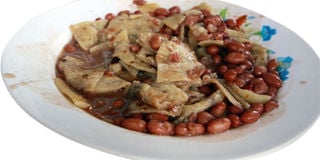Prime
Kikomando made in Uganda

A plate on kikomando. Photos by Ismail Kezaale
What you need to know:
Kikomando. “An affordable meal on the go”, best describes kikomando. The meal of chapatti and beans became popular with many a casual worker but today has been modified and is served in upscale restaurants as well.
Kikomando is a word usually used locally to refer to scenes in an action packed movie. This word has become popular with many a labour worker and boda boda man alike in reference to a combo meal. “It’s not an action movie as the name may suggest, but after you have eaten it, the satisfaction you get is equal to none,” says Geoffrey Isma, a man from Ntinda who is quite fond of the Kikomando meal. This seemingly “cuisine” that has become a big part of many city dwellers is simply a mixture of chapatti chopped into pieces with beans. It is a meal that is shared by both the rich and poor alike. Allan Kakuru, a street child hosted recently on Tuwaye, a local TV programme on Ntv, said it’s a saviour meal for many ghetto dwellers and street children on the Kampala streets.
In Uganda and other towns out of Kampala, kikomando is meal offered in many chapatti joints and make shift restaurants around the city surburbs. According to James Mugisha, a kikomando enthusiast, the roots of the meal date back to the early 2000s when people bought chapattis and chopped them in to pieces and ate the meal with beans and avocados.
By around 2003, many people especially builders and site workers had adopted the meal. This was not only because it was cheap, but it also made one satisfied so fast and could be prepared quickly. This made it a meal associated to many hardworking people. Isma, concurs with Mugisha. He asserts that he started the practice of selling chapatti and beans in 2000, in Ntinda. He said the idea of mixing chapatti and beans excited many people who started visiting his joint especially around lunch time. He later on trained many people in the practice in Kibuli, Naalya and Nakawa.
According to Isma, the name Kikomando was coined by self-proclaimed Ghetto president Bobi Wine who sang about the mixture of chapattis and beans in one of his songs. Later on, many people adopted the name which became popular especially in Kamokya.
As years passed, many chapatti joints started the practice as it fetched more money. Back then a chapatti cost Shs200 and a spoon of fried beans went for Shs100. This meal was perfectly priced at Shs300 for the average Ugandan, perhaps the reason behind its popularity and success amongst labourers and slum dwellers. This also came with additives such as avocado. However, today a kikomando meal of two chapattis and beans sets one back by Shs1,200.
Today, some upscale fast food joints have modified the meal, offering the chopped chapattis with meat stew, gravy, chicken and liver. Robert, a waiter at Chicken tonight, Kireka branch says, some people usually have it for breakfast accompanied with a cup of tea any other refreshment.
Apparently, no great skill is required for one to learn the art of cooking a kikomando meal. All one needs to master is the skill of making chapattis. You also have to fry the beans well.


